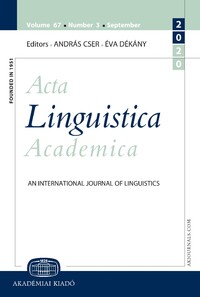Modeling declensions without declension features. The case of Russian
Modeling declensions without declension features. The case of Russian
Author(s): Pavel CahaSubject(s): Syntax
Published by: Akadémiai Kiadó
Keywords: Nanosyntax; declension; Russian; morphology; syntax
Summary/Abstract: This paper presents an analysis of the Russian declension in Nanosyntax (Starke 2009, 2018). The analysis has two theoretically important aspects. First, it makes no reference to language-particular declension features. This allows one to maintain the idea that morphosyntactic features are drawn from a set provided by the UG, i.e., language invariant. The analysis also does not use contextual rules. In order to correctly pair the right ending with a particular root, the analysis only relies on specifying each marker for the features it spells out. The correct pairing of roots and affixes falls out from such a specification and the Nanosyntax model of spellout.
- Issue Year: 68/2021
- Issue No: 4
- Page Range: 385-425
- Page Count: 41
- Language: English
- Content File-PDF

